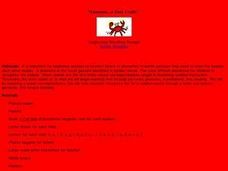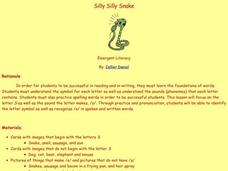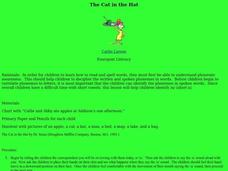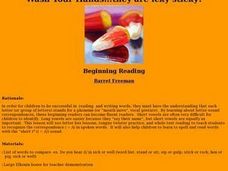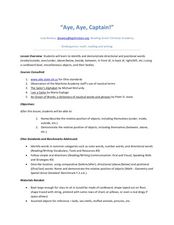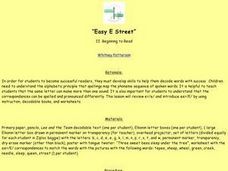Curated OER
Icky, Sticky!!
Learners participate in an emerging literacy lesson that focuses on the skill of phonemic awareness. The phoneme of choice is the letter "i". Students need to recognize the letter in correlation to its sound.
Curated OER
"Aaaaaaa...a Fast Crab! "
Students participate in an emergent literacy lesson plan that focuses on the skill of phonemic awareness. The phoneme chosen is the letter "a". They need to correlate the sound to the letter.
Curated OER
Eeeee -- It's a Mouse!
Students recognize the long "e" sound, and identify it in spoken words by learning letter symbols. Students participate in role playing and tongue twisters to learn the long "e" sound. By learning phenomes, students are taking the...
Curated OER
Emergent Literacy
Students practice speaking and spelling words, and recognize and demonstrate understanding of sounds (phonemes) that each letter contains. Students focus specifically on letter S and its sound.
Curated OER
The Cat in the Hat
First graders participate in an emergent literacy instructional activity to gain skills essential for the beginning reader. They practice the phoneme of the day or letter "A". The sound and recognition of the letter is the focus of the...
Curated OER
Baaa Baaa Black Sheep have you any Wool?
Students participate in a discussion covering the concept of phonemic awareness. They practice how letters make sounds that are combined to form written and spoken words. The teacher instructs the class by modeling the correct way to...
Curated OER
Mmmmmm Mmmmmm Yum!
Students engage in an emergent literacy lesson that focuses on phonemic awareness. The importance of the letter to sound relationship is stressed in the lesson. The letter "m" is the target phoneme for students to master.
Curated OER
Our Glittery Growing Garden!
Students answer a series of questions about the letter G. They practice the sound that G makes and trace a letter G. They decorate their letter G with glue and glitter. They listen to a story about Plainting a Rainbow.
Curated OER
Buzzing Bees
First graders engage in a lesson on phonemic awareness. They practice skills that are considered essential for good reading to occur. The skills of letter recognition and corresponding the letter to its phoneme are taught.
Curated OER
Grandpa Ed
Students engage in an emergent literacy lesson plan that focuses on phonemic awareness. For practice they become more comfortable with a short vowel phoneme, which can often be the most difficult to identify, by learning it in isolation.
Curated OER
The Door is Creaky E
Students observe the prop of a door to demonstrate the sound of the phonemic sound of the letter "e". Then they drill and practice the sound with the teacher. The essential importance of the skill of phonemic awareness is stressed in the...
Curated OER
Iiizzy is Iiicky Sticky!
Students answer a series of questions about the different sounds that the letter I makes. They observe a picture about a girl and the letter I. They practice a tongue twister with the different sounds of I. They practice writing the...
Curated OER
Wash Your Hands...they are icky sticky!
Students engage in an emergent literacy lesson that focuses on phonemic awareness and they practice corresponding the letter "i" to its long or short sound. This type of recognition has been found to be essential to reading development.
Curated OER
The Squeaky Creaky Elevator
Students engage in an emergent literacy lesson in order to help develop the skills of letter recognition and corresponding sound of the phoneme. This is done with the use of a tongue twister using the phoneme of the letter "e".
Curated OER
U-u-under The U-u-umbrella!
Students practice using phonemes because they need to be able to recognize that phonemes and letters correspond with each other in order to become a proficient reader. The practice is done using the letter "u".
Curated OER
/o/... I can't stop yawning!
Students investigate the phoneme, a meaningful representation, and the letter symbol for /o/ (short o). This instructional activity helps students recognize the /o/ in spoken words and begin to spell words with the assistance of letter...
Curated OER
Eddie the Elephant
Students need to practice sight words to become proficient readers. So it is very important for children to learn common correspondences. The phoneme for the letter "e" is practiced in this lesson.
Curated OER
"Ehh?" Says Grandpa Edward"
Students engage in an emergent literacy lesson that focuses on phonemic awareness. This lesson plan helps students to identify the correspondence e=/e/ by recognizing the sound of an elderly person ¿¿¿eh?¿¿¿ throughout words.
Curated OER
The Pink Pig Gets Icky Sticky
Students recognize that the letter "i" alone in written text will map out the /i/ phoneme in spoken words. By helping them with this short vowel mapping knowledge is further increased and decoding skills improve.
Curated OER
Ew!!! It's Icky Sticky!
Students engage in an emergent literacy lesson that focuses upon the skill of phonemic awareness. The phoneme sound for the letter "i" is used with a tongue twister to build this important reading skill.
Curated OER
Aye, Aye Captain
Students investigate how correspondences appear differently in different words. They also recognize the difference between long and short vowels. Students study how these correspondences are spelled and pronounced differently.
Curated OER
O-O-O-O-O, I get it!
Students engage in an emergent literacy lesson that focuses on the skill of phonemic awareness. To practice the skill the phoneme for the letter "o" is used. The students need to recognize the letter and its corresponding sound.
Curated OER
"Easy E Street"
Students investigate how the same letter can make more than one sound. It is also important for students to understand that the correspondences can be spelled and pronounced differently. This lesson will review e=/e/ and introduce ee=/E/...
Curated OER
O-o-o-oh, no-o-o-o!!
Pupils engage in an emergent literacy lesson plan in order to practice the skill of phonemic awareness. They learn this skill using the phoneme for the letter "o". Students must recognize the letter as well as its sound.



